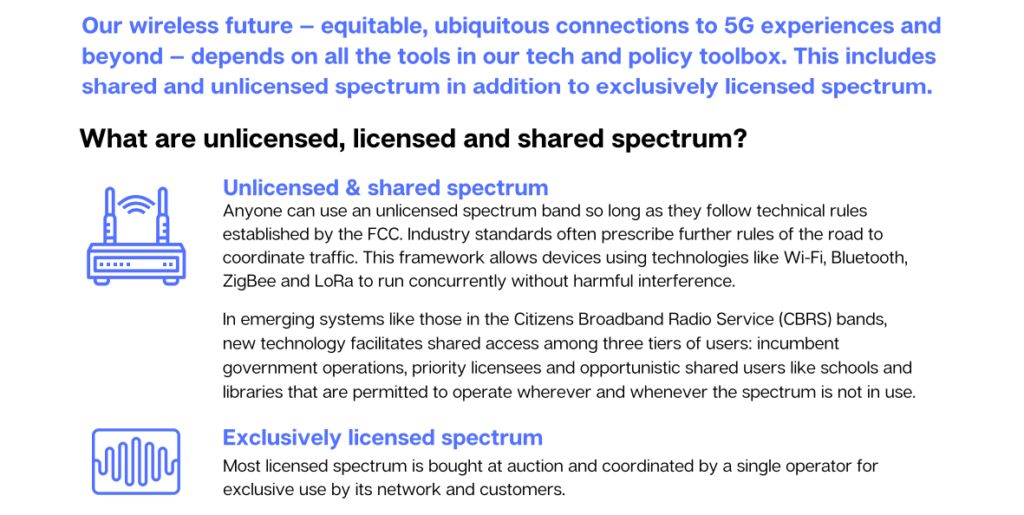Frequently cited in conversations surrounding spectrum policy is the fact that these coveted frequencies are a finite resource, for which we must come to an even-handed agreement on shared, licensed and unlicensed use. How do we craft the best regulatory approach that maximizes spectrum’s potential, spurs innovation and the tech economy and helps bridge the digital divide?

Photo by Julien Maculan on Unsplash
New from WifiForward is a series we’ve termed Frequency Pulse. For this first edition, we asked a number of industry experts to respond to this prompt: What does the Biden Administration need to know about balanced spectrum policy?
With this week’s official nominations of Jessica Rosenworcel and Gigi Sohn to the FCC and Alan Davidson to the NTIA, these discussions are more relevant and important than ever. We’re honored to provide a platform for this dialogue.
For additional background, see our explainer on licensed and unlicensed spectrum, as well as benefits of shared spectrum.
Sign up to receive the next Frequency Pulse newsletter by emailing wififorward@glenechogroup.com.
Harold Feld, Public Knowledge, Senior Vice President:
Like licensed spectrum, we need a pipeline of unlicensed spectrum in low, mid and high frequencies that will provide innovators and users with a reliable and steadily expanding inventory of spectrum to meet increasing demand. Additionally, we must promote and expand hybrid models such as the 3.5 CBRS band.
Kristian Stout, ICLE, Director of Innovation Policy:
Much of innovation comes from unknown quarters. The administration is to take care to ensure that spectrum can be efficiently used by both incumbents and as-yet-unforeseen innovators.
Bartlett Cleland, Innovation Economy Institute, Executive Director:
For a long time, certain bands of spectrum were left to be used without a license from the FCC. Being unlicensed, this spectrum is more affordable than licensed spectrum. This spectrum is available to innovators without specific permission to put it to use, only requiring the following of well-known user rules. Regulatory oversight is light, the opportunity for entrepreneurs great and the benefits for consumers are many. Regulatory oversight must remain light for this former “junk band” to remain valuable.
Licensed spectrum is also valuable and critical. Because this spectrum is allocated via a market mechanism, this allows the licenses to be awarded to those who value it most highly and to use it in some way to further their market aspirations. That is to say, to use that spectrum in a way they see as its highest and best use. Valued products and services typically follow, as industry seeks to make a return on the expenditure made to acquire the license.
In the end, both licensed and unlicensed spectrum are valuable to the country. By having both, we gain from innovation as well as a predictable set of products and services.
David Coleman, Extreme Networks – Director of Wireless, Office of the CTO:
A balanced spectrum policy is just plain common sense. While licensed spectrum is needed for many industries, it has been consistently proven that the availability of unlicensed spectrum for public always triggers economic growth. Wi-Fi is a technology built on unlicensed spectrum that provides close to $1 Trillion of economic value to the United States per year. Furthermore, a balanced policy provides an established path for technical innovation.
Danielle Pineres, Vice President & Associate General Counsel, NCTA – The Internet & Television Association:
Different regulatory approaches to spectrum are like different tools in a toolbox. Just like different tools are useful for different jobs, licensed, shared and unlicensed spectrum bands are useful for different use cases. Successful spectrum policy balances the need for exclusive use, licensed spectrum with shared spectrum and unlicensed spectrum, which provide low barriers to entry access to a wide variety of spectrum users and innovators. If a country adopts policies that favor one tool over the other, for example by not opening enough spectrum to unlicensed and shared spectrum technologies, it will undermine economic growth and innovation.
Now it’s your turn: tweet us or email us with your take on balanced spectrum policy to join this conversation. We might feature thoughtful submissions right here in a future piece.

